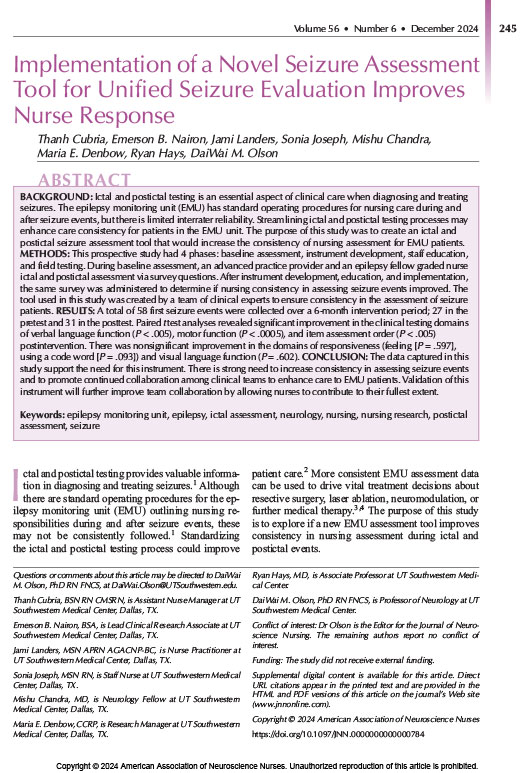Implementation of a Novel Seizure Assessment Tool for Unified Seizure Evaluation Improves Nurse Response
August 2025 | Journal of Neuroscience Nursing
Abstract
Background
Ictal and postictal testing is an essential aspect of clinical care when diagnosing and treating seizures. The epilepsy monitoring unit (EMU) has standard operating procedures for nursing care during and after seizure events, but there is limited interrater reliability. Streamlining ictal and postictal testing processes may enhance care consistency for patients in the EMU unit. The purpose of this study was to create an ictal and postictal seizure assessment tool that would increase the consistency of nursing assessment for EMU patients.
Methods
This prospective study had 4 phases: baseline assessment, instrument development, staff education, and field testing. During baseline assessment, an advanced practice provider and an epilepsy fellow graded nurse ictal and postictal assessment via survey questions. After instrument development, education, and implementation, the same survey was administered to determine if nursing consistency in assessing seizure events improved. The tool used in this study was created by a team of clinical experts to ensure consistency in the assessment of seizure patients.
Results
A total of 58 first seizure events were collected over a 6-month intervention period; 27 in the pretest and 31 in the posttest. Paired t test analyses revealed significant improvement in the clinical testing domains of verbal language function (P < .005), motor function (P < .0005), and item assessment order (P < .005) postintervention. There was nonsignificant improvement in the domains of responsiveness (feeling [P = .597], using a code word [P = .093]) and visual language function (P = .602).
Conclusion
The data captured in this study support the need for this instrument. There is strong need to increase consistency in assessing seizure events and to promote continued collaboration among clinical teams to enhance care to EMU patients. Validation of this instrument will further improve team collaboration by allowing nurses to contribute to their fullest extent.

